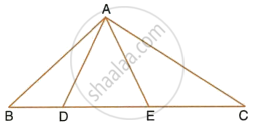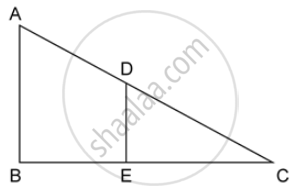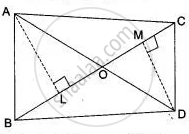Advertisements
Advertisements
Question
In the given figure, AB and DE are perpendiculars to BC.
Find the ratio of the area of a ΔABC : area of ΔDEC.

Solution
In ΔABC and ΔDEC,
∠ABC = ∠DEC ...(both are right angles)
∠ACB = ∠DCE ....(common angles)
ΔABC ∼ ΔDEC ...(AA criterion for similarity)
`=> (ar (DeltaABC))/(ar (DeltaDEC)) = (AB^2)/(DE^2) = (6^2)/(4^2) = 36/16`
`=> (ar (DeltaABC))/(ar (DeltaDEC)) = 9/4`
APPEARS IN
RELATED QUESTIONS
P is a point on side BC of a parallelogram ABCD. If DP produced meets AB produced at point L, prove that: DP : PL = DC : BL.
In the given figure, AB || DC, BO = 6 cm and DQ = 8 cm; find: BP × DO.

In the given figure, AD = AE and AD2 = BD × EC. Prove that: triangles ABD and CAE are similar.

In the given figure, AB and DE are perpendiculars to BC.
If AB = 6 cm, DE = 4 cm and AC = 15 cm. Calculate CD.

ABC is a right angled triangle with ∠ABC = 90°. D is any point on AB and DE is perpendicular to AC. Prove that :

ΔADE ~ ΔACB.
In figure ABC and DBC are two triangles on the same base BC. Prove that
`"Area (ΔABC)"/"Area (ΔDBC)" = "AO"/"DO"`.
Two isosceles triangle have equal vertical angles and their areas are in the ratio of 36 : 25. Find the ratio between their corresponding heights.
In the adjoining figure ABC is a right angle triangle with ∠BAC = 90°, and AD ⊥ BC.
(i) Prove ΔADB ∼ ΔCDA.
(ii) If BD = 18 cm, CD = 8 cm find AD.
(iii) Find the ratio of the area of ΔADB is to area of ΔCDA.
In the given figure ΔABC and ΔAMP are right angled at B and M respectively.
Given AC = 10 cm, AP = 15 cm and PM = 12 cm.
(i) Prove ΔABC ∼ Δ AMP.
(ii) Find AB and BC.
Triangles ABC and DEF are similar.
If area (ΔABC) = 9 cm2, area (ΔDEF) = 64 cm2 and BC = 5·1 cm find AB.
